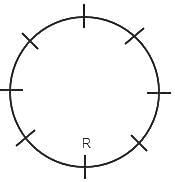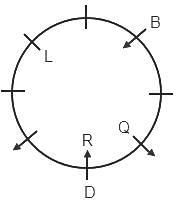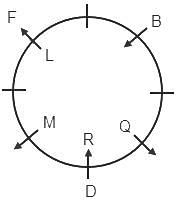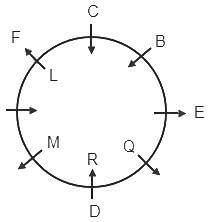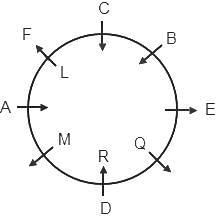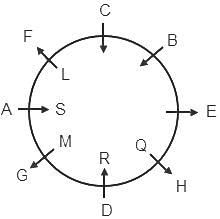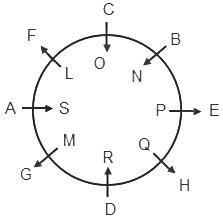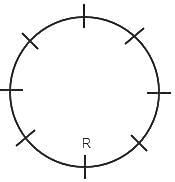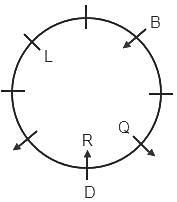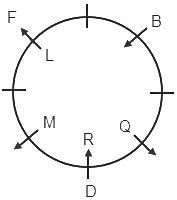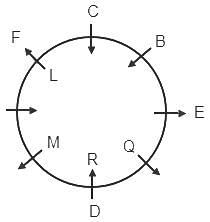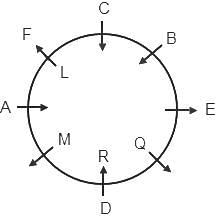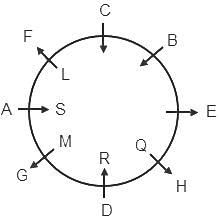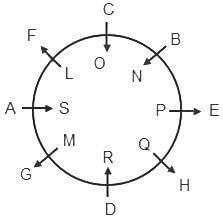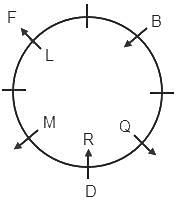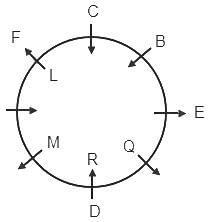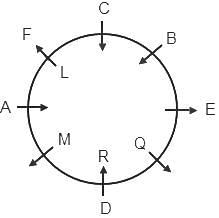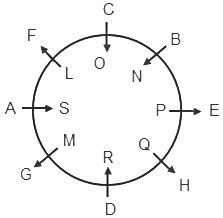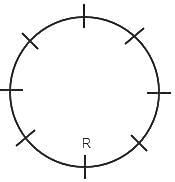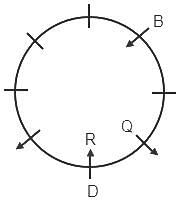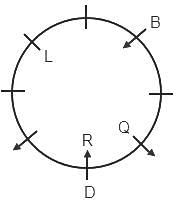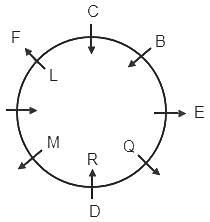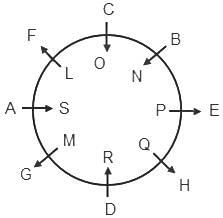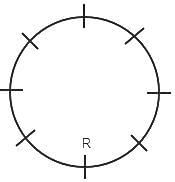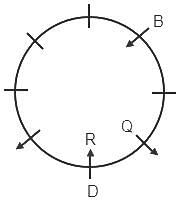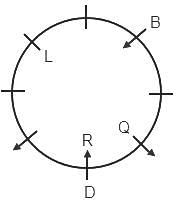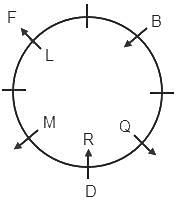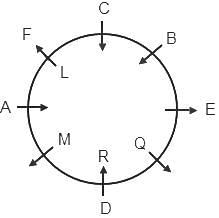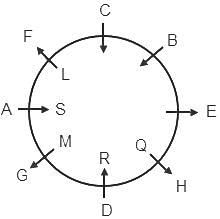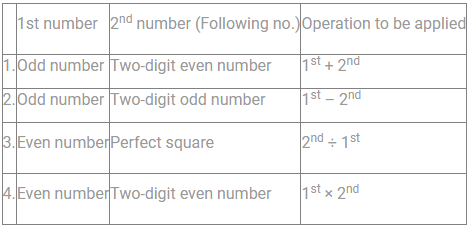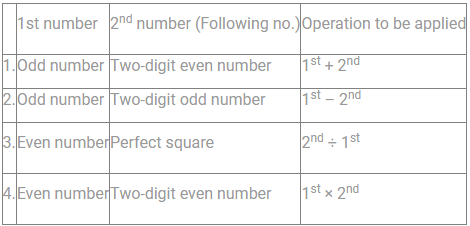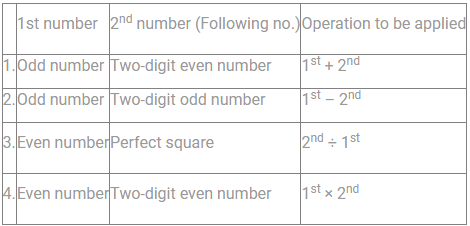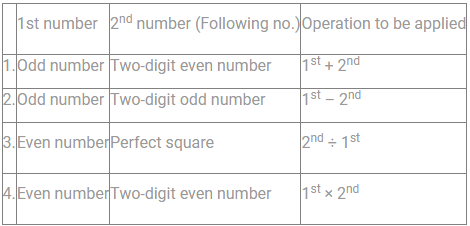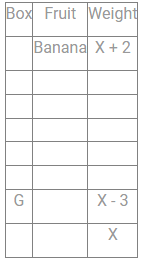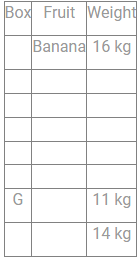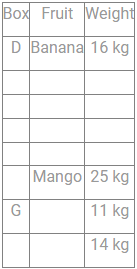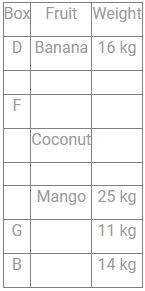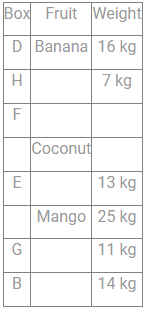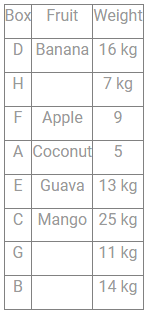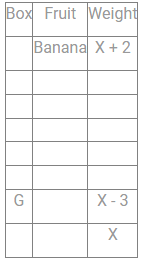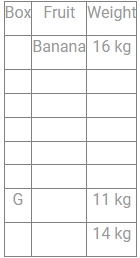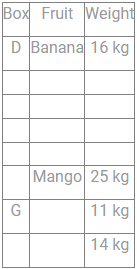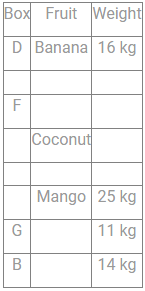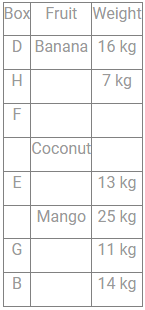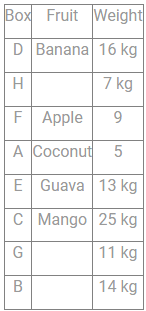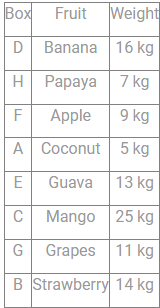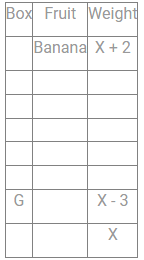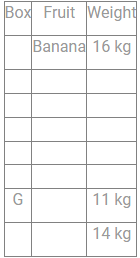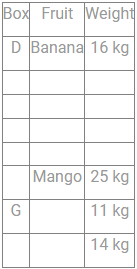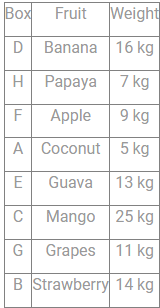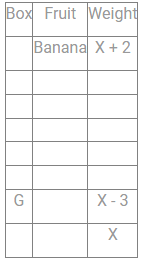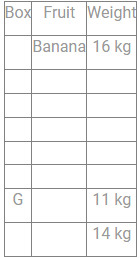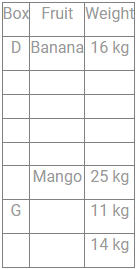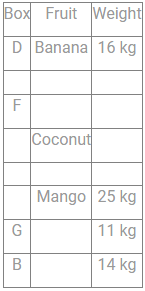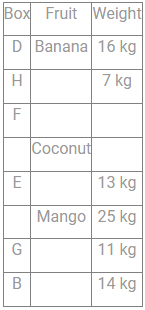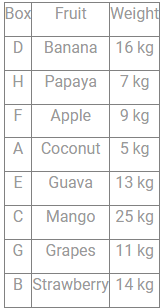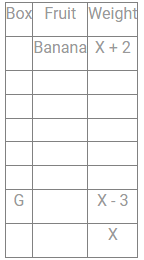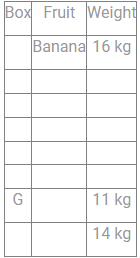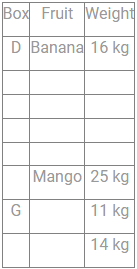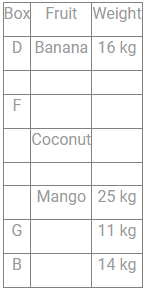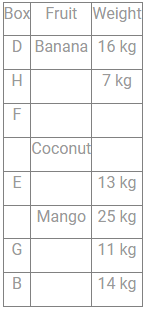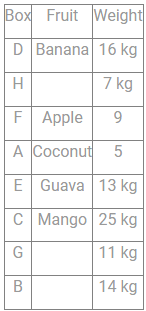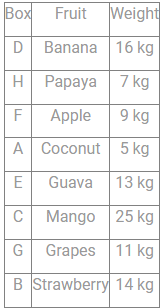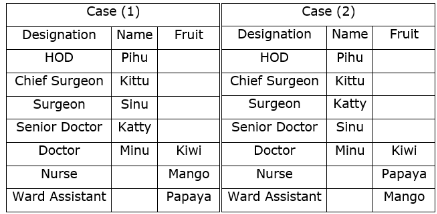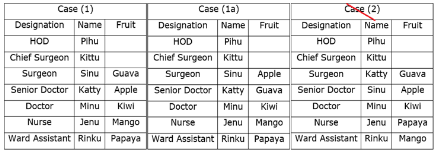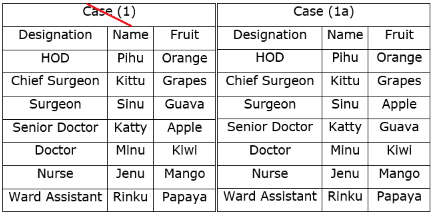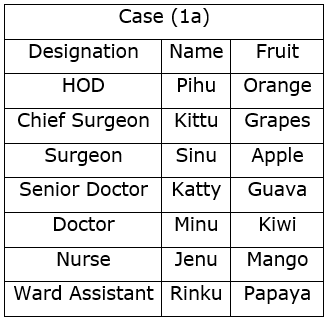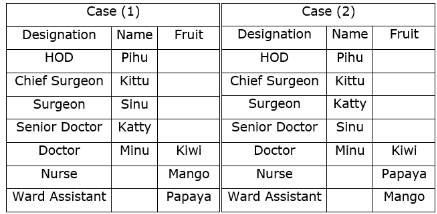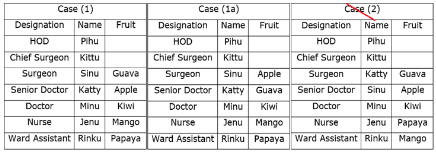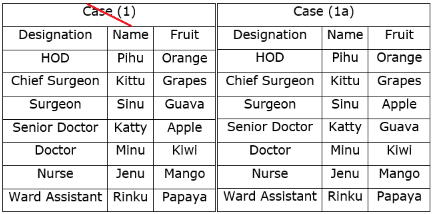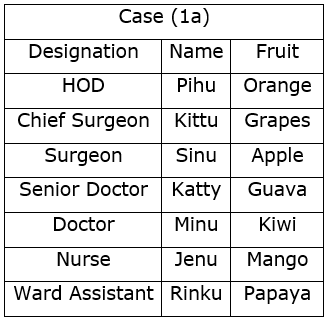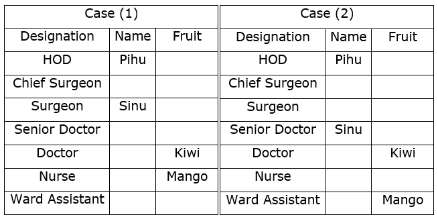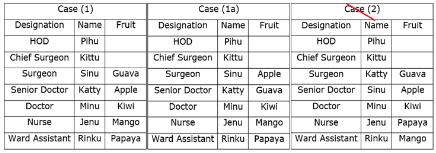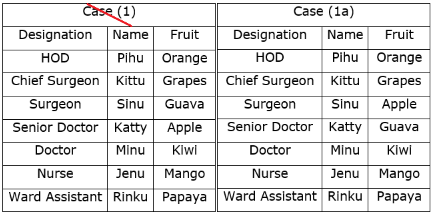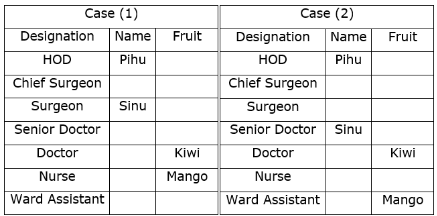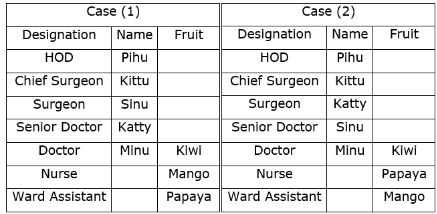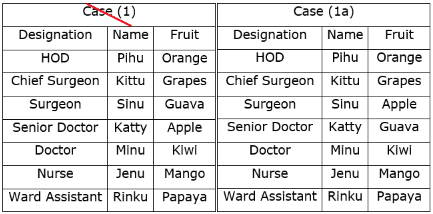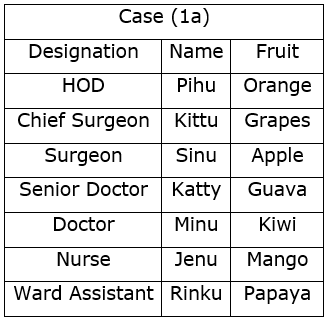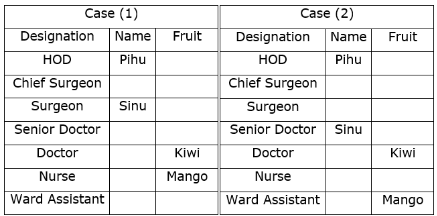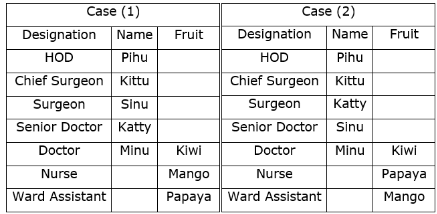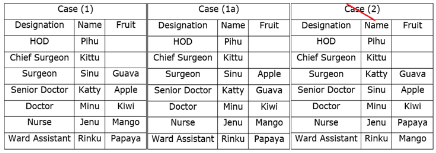IBPS Clerk Mains Mock Test - 1 - Bank Exams MCQ
30 Questions MCQ Test - IBPS Clerk Mains Mock Test - 1
Below questions consist of some numbers in two rows. Resultant of each row can be determined by performing some operations. Study the following information carefully and answer the below questions.
Condition:
I. If an even number is followed by a number which is a multiple of 3, then four is added to the positive difference of both numbers.
II. If an even number is followed by a number which is not a multiple of 3, then five is subtracted from the sum of both numbers.
III. If an odd number(not a prime number) is followed by a prime number, then the product of the tenth digit of both numbers is taken.
IV. If a prime number is followed by a composite number, then the product of unit digits of both numbers is taken.
V. If a prime number is followed by another prime number, then the sum of both numbers is taken.
Note: If more than one condition follows then only one condition is applied in the given sequence.
Q. What is the sum of the resultant of both rows?
14 18 7
21 43 27
Below questions consist of some numbers in two rows. Resultant of each row can be determined by performing some operations. Study the following information carefully and answer the below questions.
Condition:
I. If an even number is followed by a number which is a multiple of 3, then four is added to the positive difference of both numbers.
II. If an even number is followed by a number which is not a multiple of 3, then five is subtracted from the sum of both numbers.
III. If an odd number(not a prime number) is followed by a prime number, then the product of the tenth digit of both numbers is taken.
IV. If a prime number is followed by a composite number, then the product of unit digits of both numbers is taken.
V. If a prime number is followed by another prime number, then the sum of both numbers is taken.
Note: If more than one condition follows then only one condition is applied in the given sequence.
Q. What is the difference between the resultant of both rows?
7 5 25
17 14 9
Below questions consist of some numbers in two rows. Resultant of each row can be determined by performing some operations. Study the following information carefully and answer the below questions.
Condition:
I. If an even number is followed by a number which is a multiple of 3, then four is added to the positive difference of both numbers.
II. If an even number is followed by a number which is not a multiple of 3, then five is subtracted from the sum of both numbers.
III. If an odd number(not a prime number) is followed by a prime number, then the product of the tenth digit of both numbers is taken.
IV. If a prime number is followed by a composite number, then the product of unit digits of both numbers is taken.
V. If a prime number is followed by another prime number, then the sum of both numbers is taken.
Note: If more than one condition follows then only one condition is applied in the given sequence.
Q. If Y is the result of row 1 then what is the resultant of row 2?
15 31 11
7 26 Y
Direction: Read the instructions carefully and answer the question below.
A, B, C, D, E, F, G, and H are the eight male members sitting around a circular table. Four of them are facing the inward direction and four are facing the outward direction. These eight people are married to eight girls namely L, M, N, O, P, Q, R, and S but not necessarily in the same order. No three consecutive people are facing the same direction.
Only one person is sitting between B and the husband of L. Both the immediate neighbors of D are facing the same direction. Either R or P is the wife of D. The husband of Q is facing the outward direction and he is sitting to the immediate right of D. B is sitting third to the right of the person who is the husband of R and they are facing the same direction. The husband of P and the husband of Q are facing the same direction. The wife of D is sitting third to the left of F. Neither O nor P is the wife of B. G is sitting third to the right of C. The husband of L is sitting third to the left of E. Only one person is sitting between F and the husband of M and they are facing the same direction. The husband of S is sitting third to the right of H. A is an immediate neighbour of the husband of M. C is sitting third to the right of the husband of M and they are facing different directions.
Q. Who is the husband of S?
Direction: Read the instructions carefully and answer the question below.
A, B, C, D, E, F, G, and H are the eight male members sitting around a circular table. Four of them are facing the inward direction and four are facing the outward direction. These eight people are married to eight girls namely L, M, N, O, P, Q, R, and S but not necessarily in the same order. No three consecutive people are facing the same direction.
Only one person is sitting between B and the husband of L. Both the immediate neighbors of D are facing the same direction. Either R or P is the wife of D. The husband of Q is facing the outward direction and he is sitting to the immediate right of D. B is sitting third to the right of the person who is the husband of R and they are facing the same direction. The husband of P and the husband of Q are facing the same direction. The wife of D is sitting third to the left of F. Neither O nor P is the wife of B. G is sitting third to the right of C. The husband of L is sitting third to the left of E. Only one person is sitting between F and the husband of M and they are facing the same direction. The husband of S is sitting third to the right of H. A is an immediate neighbour of the husband of M. C is sitting third to the right of the husband of M and they are facing different directions.
Q. Who is sitting to the immediate right of the husband of N?
Direction: Read the instructions carefully and answer the question below.
A, B, C, D, E, F, G, and H are the eight male members sitting around a circular table. Four of them are facing the inward direction and four are facing the outward direction. These eight people are married to eight girls namely L, M, N, O, P, Q, R, and S but not necessarily in the same order. No three consecutive people are facing the same direction.
Only one person is sitting between B and the husband of L. Both the immediate neighbors of D are facing the same direction. Either R or P is the wife of D. The husband of Q is facing the outward direction and he is sitting to the immediate right of D. B is sitting third to the right of the person who is the husband of R and they are facing the same direction. The husband of P and the husband of Q are facing the same direction. The wife of D is sitting third to the left of F. Neither O nor P is the wife of B. G is sitting third to the right of C. The husband of L is sitting third to the left of E. Only one person is sitting between F and the husband of M and they are facing the same direction. The husband of S is sitting third to the right of H. A is an immediate neighbour of the husband of M. C is sitting third to the right of the husband of M and they are facing different directions.
Q. Who is sitting second to the left of the husband of Q?
Direction: Read the instructions carefully and answer the question below.
A, B, C, D, E, F, G, and H are the eight male members sitting around a circular table. Four of them are facing the inward direction and four are facing the outward direction. These eight people are married to eight girls namely L, M, N, O, P, Q, R, and S but not necessarily in the same order. No three consecutive people are facing the same direction.
Only one person is sitting between B and the husband of L. Both the immediate neighbors of D are facing the same direction. Either R or P is the wife of D. The husband of Q is facing the outward direction and he is sitting to the immediate right of D. B is sitting third to the right of the person who is the husband of R and they are facing the same direction. The husband of P and the husband of Q are facing the same direction. The wife of D is sitting third to the left of F. Neither O nor P is the wife of B. G is sitting third to the right of C. The husband of L is sitting third to the left of E. Only one person is sitting between F and the husband of M and they are facing the same direction. The husband of S is sitting third to the right of H. A is an immediate neighbour of the husband of M. C is sitting third to the right of the husband of M and they are facing different directions.
Q. Who is the wife of the person who is sitting to the immediate left of D?
Direction: Read the instructions carefully and answer the question below.
A, B, C, D, E, F, G, and H are the eight male members sitting around a circular table. Four of them are facing the inward direction and four are facing the outward direction. These eight people are married to eight girls namely L, M, N, O, P, Q, R, and S but not necessarily in the same order. No three consecutive people are facing the same direction.
Only one person is sitting between B and the husband of L. Both the immediate neighbors of D are facing the same direction. Either R or P is the wife of D. The husband of Q is facing the outward direction and he is sitting to the immediate right of D. B is sitting third to the right of the person who is the husband of R and they are facing the same direction. The husband of P and the husband of Q are facing the same direction. The wife of D is sitting third to the left of F. Neither O nor P is the wife of B. G is sitting third to the right of C. The husband of L is sitting third to the left of E. Only one person is sitting between F and the husband of M and they are facing the same direction. The husband of S is sitting third to the right of H. A is an immediate neighbour of the husband of M. C is sitting third to the right of the husband of M and they are facing different directions.
Q. Who is sitting second to the right of the husband of P?
Study the following information carefully and answer the below questions.
Letters of three five-letter words are written against the first fifteen odd numbers from left to right . All the letters within the word are arranged in alphabetical order.
The letters of the word “MOVIE” are placed against the numbers which are multiples of three. Three letters are placed between M and R. The number of letters placed to the right of R is the same as the number of letters placed to the left of C. Four letters are placed between C and U. D is placed fifth to the left of N, which is placed to the right of C. The number of letters placed between D and I is one more than the number of letters placed between W and R. O is one of the letters of the second word placed exactly between N and V.
Q. What is the position of C with respect to N?
Study the following information carefully and answer the below questions.
Letters of three five-letter words are written against the first fifteen odd numbers from left to right . All the letters within the word are arranged in alphabetical order.
The letters of the word “MOVIE” are placed against the numbers which are multiples of three. Three letters are placed between M and R. The number of letters placed to the right of R is the same as the number of letters placed to the left of C. Four letters are placed between C and U. D is placed fifth to the left of N, which is placed to the right of C. The number of letters placed between D and I is one more than the number of letters placed between W and R. O is one of the letters of the second word placed exactly between N and V.
Q. How many letters are placed to the right of U?
Study the following information carefully and answer the below questions.
Letters of three five-letter words are written against the first fifteen odd numbers from left to right . All the letters within the word are arranged in alphabetical order.
The letters of the word “MOVIE” are placed against the numbers which are multiples of three. Three letters are placed between M and R. The number of letters placed to the right of R is the same as the number of letters placed to the left of C. Four letters are placed between C and U. D is placed fifth to the left of N, which is placed to the right of C. The number of letters placed between D and I is one more than the number of letters placed between W and R. O is one of the letters of the second word placed exactly between N and V.
Q. Four of the following five are alike in a certain way as per the given arrangement and thus form a group. Find the one that does not belong to that group?
Study the following information carefully and answer the below questions.
Letters of three five-letter words are written against the first fifteen odd numbers from left to right . All the letters within the word are arranged in alphabetical order.
The letters of the word “MOVIE” are placed against the numbers which are multiples of three. Three letters are placed between M and R. The number of letters placed to the right of R is the same as the number of letters placed to the left of C. Four letters are placed between C and U. D is placed fifth to the left of N, which is placed to the right of C. The number of letters placed between D and I is one more than the number of letters placed between W and R. O is one of the letters of the second word placed exactly between N and V.
Q. Which of the following statement is not true?
Direction: In making decisions about an important question, it is desirable to be able to distinguish between Strong arguments and Weak arguments. Strong arguments are those, which are both important and directly related to the question. Weak arguments are those, which are of minor importance and also may not be directly related to the question or may be related to a trivial aspect of the question. The question below is followed by two arguments numbered I and II. You have to decide which of the arguments a Strong argument is and which a Weak argument is.
Statement:
Does Rajasthan require a better education system?
Arguments:
I. Yes, it will enhance the knowledge of the people and will make them broad-minded.
II. No, in fact, every state in India requires a better education system.
Direction: In the following question two rows of numbers are given. The resultant number in each row is to be worked out separately based on the following rules and the question below the rows of numbers are to be answered. The operations of numbers progress from left to right.
Rules:
i) If an odd number is followed by a two digit even number then they are to be added.
ii) If an odd number is followed by a two digit odd number then the second number is to be subtracted from the first number.
iii) If an even number is followed by a number which is a perfect square of a number then the second number is to be divided by the first number.
iv) If an even number is followed by a two digit even number then the first number is to be multiplied by the second number.
6 36 36 12
17 13 12 144
Q. What is the difference between the resultant of the first set of numbers and the second set of numbers?
Direction: In the following question two rows of numbers are given. The resultant number in each row is to be worked out separately based on the following rules and the question below the rows of numbers are to be answered. The operations of numbers progress from left to right.
Rules:
(i) If an odd number is followed by a two digit even number then they are to be added.
(ii) If an odd number is followed by a two digit odd number then the second number is to be subtracted from the first number.
(iii) If an even number is followed by a number which is a perfect square of a number then the second number is to be divided by the first number.
(iv) If an even number is followed by a two digit even number then the first number is to be multiplied by the second number.
21 19 16
25 23 12
Q. If the resultant of the first sets of numbers is multiplied by the resultant of the second sets of numbers, what will be the outcome?
Direction: In the following question two rows of numbers are given. The resultant number in each row is to be worked out separately based on the following rules and the question below the rows of numbers are to be answered. The operations of numbers progress from left to right.
Rules:
(i) If an odd number is followed by a two digit even number then they are to be added.
(ii) If an odd number is followed by a two digit odd number then the second number is to be subtracted from the first number.
(iii) If an even number is followed by a number which is a perfect square of a number then the second number is to be divided by the first number.
(iv) If an even number is followed by a two digit even number then the first number is to be multiplied by the second number.
30 60 3600
15 22 19
Q. What is the sum of the two resultant numbers of the set of numbers given above?
Direction: In the following question two rows of numbers are given. The resultant number in each row is to be worked out separately based on the following rules and the question below the rows of numbers are to be answered. The operations of numbers progress from left to right.
Rules:
(i) If an odd number is followed by a two digit even number then they are to be added.
(ii) If an odd number is followed by a two digit odd number then the second number is to be subtracted from the first number.
(iii) If an even number is followed by a number which is a perfect square of a number then the second number is to be divided by the first number.
(iv) If an even number is followed by a two digit even number then the first number is to be multiplied by the second number.
55 45 12
25 10 33 16
Q. If the resultant of the second set of numbers is subtracted from the resultant of the first set of numbers what will be the outcome?
In each of the following questions, the relationship between different elements are given in the statement followed by two sets of conclusions. Study the following information carefully and decide which of the following conclusion logically follows.
“A @ B” means “A is greater than B”
“A % B” means “A is not greater than B”
“A # B” means “A is less than B”
“A & B” means “A is not less than B”
“A ^ B” means “A is neither greater than nor less than B"
Q. Statements:
L @ Q & M ^ P; R % N ^ G % P
Conclusions:
(I) Q @ R
(II) R ^ Q
In each of the following questions, the relationship between different elements are given in the statement followed by two sets of conclusions. Study the following information carefully and decide which of the following conclusion logically follows.
“A @ B” means “A is greater than B”
“A % B” means “A is not greater than B”
“A # B” means “A is less than B”
“A & B” means “A is not less than B”
“A ^ B” means “A is neither greater than nor less than B"
Q. Statements:
S @ N & Q ^ R; L ^ J % R; L # T @ M
Conclusions:
(I) T @ Q
(II) N & L
In each of the following questions, the relationship between different elements are given in the statement followed by two sets of conclusions. Study the following information carefully and decide which of the following conclusion logically follows.
“A @ B” means “A is greater than B”
“A % B” means “A is not greater than B”
“A # B” means “A is less than B”
“A & B” means “A is not less than B”
“A ^ B” means “A is neither greater than nor less than B"
Q. Statements:
M % T # S ^ Z # A; M & X & Y ^ C
Conclusions:
(I) C % T
(II) A @ Y
Direction: Read the instructions carefully and answer the question below.
A, B, C, D, E, F, G, and H are the eight boxes that are kept one above the other but not necessarily in the same order. These boxes contain eight different fruits namely Coconut, Apples, Mangoes, Grapes, Guava, Strawberry, Papaya, and Banana, but not necessarily in the same order. The total weights of these eight boxes are 100 kg. No two box has the same weight.
Box D is kept five boxes above the box that contains Mangoes. Five boxes are kept between box G and the box that contains Banana. The difference between the weights of the box that contains Mangoes and the box that is kept immediately below it is 14 kg. At least five boxes are kept above box G which weighs 3 kg less than the box that is kept immediately below it. The total weight of the boxes that are kept at the top and bottom is 30 kg. The box that contains Banana is 5 kg heavier than box G. The box that contains Apples is kept immediately above box A and it is 4 kg heavier than box A. Box E is kept immediately below the box that contains Coconut and it weighs 6 kg more than box H. The box that contains Grapes is heavier than the box that contains Papaya. Two boxes are kept between box E and box H and their total weight is 20 kg. Four boxes are kept between box B and box F. Four boxes are kept between the boxes that contain Papaya and Grapes. Two boxes are kept between the box that contains Guava and box B. The box that contains Coconut is kept immediately below box F and the total weight of these two boxes is same as that of box B.
Q. Which box is kept immediately above the box that contains Mangoes?
Direction: Read the instructions carefully and answer the question below.
A, B, C, D, E, F, G, and H are the eight boxes that are kept one above the other but not necessarily in the same order. These boxes contain eight different fruits namely Coconut, Apples, Mangoes, Grapes, Guava, Strawberry, Papaya, and Banana, but not necessarily in the same order. The total weights of these eight boxes are 100 kg. No two box has the same weight.
Box D is kept five boxes above the box that contains Mangoes. Five boxes are kept between box G and the box that contains Banana. The difference between the weights of the box that contains Mangoes and the box that is kept immediately below it is 14 kg. At least five boxes are kept above box G which weighs 3 kg less than the box that is kept immediately below it. The total weight of the boxes that are kept at the top and bottom is 30 kg. The box that contains Banana is 5 kg heavier than box G. The box that contains Apples is kept immediately above box A and it is 4 kg heavier than box A. Box E is kept immediately below the box that contains Coconut and it weighs 6 kg more than box H. The box that contains Grapes is heavier than the box that contains Papaya. Two boxes are kept between box E and box H and their total weight is 20 kg. Four boxes are kept between box B and box F. Four boxes are kept between the boxes that contain Papaya and Grapes. Two boxes are kept between the box that contains Guava and box B. The box that contains Coconut is kept immediately below box F and the total weight of these two boxes is same as that of box B.
Q. The box that is kept at the bottom contains which fruit?
Direction: Read the instructions carefully and answer the question below.
A, B, C, D, E, F, G, and H are the eight boxes that are kept one above the other but not necessarily in the same order. These boxes contain eight different fruits namely Coconut, Apples, Mangoes, Grapes, Guava, Strawberry, Papaya, and Banana, but not necessarily in the same order. The total weights of these eight boxes are 100 kg. No two box has the same weight.
Box D is kept five boxes above the box that contains Mangoes. Five boxes are kept between box G and the box that contains Banana. The difference between the weights of the box that contains Mangoes and the box that is kept immediately below it is 14 kg. At least five boxes are kept above box G which weighs 3 kg less than the box that is kept immediately below it. The total weight of the boxes that are kept at the top and bottom is 30 kg. The box that contains Banana is 5 kg heavier than box G. The box that contains Apples is kept immediately above box A and it is 4 kg heavier than box A. Box E is kept immediately below the box that contains Coconut and it weighs 6 kg more than box H. The box that contains Grapes is heavier than the box that contains Papaya. Two boxes are kept between box E and box H and their total weight is 20 kg. Four boxes are kept between box B and box F. Four boxes are kept between the boxes that contain Papaya and Grapes. Two boxes are kept between the box that contains Guava and box B. The box that contains Coconut is kept immediately below box F and the total weight of these two boxes is same as that of box B.
Q. What is the weight of the box that is kept immediately below box D?
Direction: Read the instructions carefully and answer the question below.
A, B, C, D, E, F, G, and H are the eight boxes that are kept one above the other but not necessarily in the same order. These boxes contain eight different fruits namely Coconut, Apples, Mangoes, Grapes, Guava, Strawberry, Papaya, and Banana, but not necessarily in the same order. The total weights of these eight boxes are 100 kg. No two box has the same weight.
Box D is kept five boxes above the box that contains Mangoes. Five boxes are kept between box G and the box that contains Banana. The difference between the weights of the box that contains Mangoes and the box that is kept immediately below it is 14 kg. At least five boxes are kept above box G which weighs 3 kg less than the box that is kept immediately below it. The total weight of the boxes that are kept at the top and bottom is 30 kg. The box that contains Banana is 5 kg heavier than box G. The box that contains Apples is kept immediately above box A and it is 4 kg heavier than box A. Box E is kept immediately below the box that contains Coconut and it weighs 6 kg more than box H. The box that contains Grapes is heavier than the box that contains Papaya. Two boxes are kept between box E and box H and their total weight is 20 kg. Four boxes are kept between box B and box F. Four boxes are kept between the boxes that contain Papaya and Grapes. Two boxes are kept between the box that contains Guava and box B. The box that contains Coconut is kept immediately below box F and the total weight of these two boxes is same as that of box B.
Q. Which box is the heaviest?
Direction: Read the instructions carefully and answer the question below.
A, B, C, D, E, F, G, and H are the eight boxes that are kept one above the other but not necessarily in the same order. These boxes contain eight different fruits namely Coconut, Apples, Mangoes, Grapes, Guava, Strawberry, Papaya, and Banana, but not necessarily in the same order. The total weights of these eight boxes are 100 kg. No two box has the same weight.
Box D is kept five boxes above the box that contains Mangoes. Five boxes are kept between box G and the box that contains Banana. The difference between the weights of the box that contains Mangoes and the box that is kept immediately below it is 14 kg. At least five boxes are kept above box G which weighs 3 kg less than the box that is kept immediately below it. The total weight of the boxes that are kept at the top and bottom is 30 kg. The box that contains Banana is 5 kg heavier than box G. The box that contains Apples is kept immediately above box A and it is 4 kg heavier than box A. Box E is kept immediately below the box that contains Coconut and it weighs 6 kg more than box H. The box that contains Grapes is heavier than the box that contains Papaya. Two boxes are kept between box E and box H and their total weight is 20 kg. Four boxes are kept between box B and box F. Four boxes are kept between the boxes that contain Papaya and Grapes. Two boxes are kept between the box that contains Guava and box B. The box that contains Coconut is kept immediately below box F and the total weight of these two boxes is same as that of box B.
Q. What is the weight of the box that contains Papaya?
Study the following information carefully and answer the below questions.
Seven medical persons – Jenu, Sinu, Minu, Kittu, Pihu, Rinku, and Katty are working in an organization with different positions viz.- HOD, Chief Surgeon, Surgeon, Senior Doctor, Doctor, Nurse, and Ward Assistant. The designation of the persons is given in decreasing order such that HOD is the seniormost whereas ward assistant is the juniormost. Each person likes different fruits viz.- Mango, Apple, Orange, Papaya, Guava, Grapes, and Kiwi. All the information is not necessary in the same order.
Only two persons are junior to the one who likes Kiwi. Three persons are designated between the one who likes Kiwi and Pihu. Sinu is three positions senior to the one who likes Mango. Kittu is not designated as Surgeon. Katty is senior to Minu and the one who likes Papaya but not senior to Kittu. Minu likes neither Mango nor papaya. Sinu likes neither Papaya nor Grapes. The number of persons designated between Jenu and the one who likes Apple is one less than the number of persons senior to the one who likes Guava. Rinku doesn’t like Mango. Atleast one person is designated between the one who likes Guava and the one who likes Grapes. . The one who likes Grapes is not designated as HOD.
Q. Who among the following person likes Apple?
Study the following information carefully and answer the below questions.
Seven medical persons – Jenu, Sinu, Minu, Kittu, Pihu, Rinku, and Katty are working in an organization with different positions viz.- HOD, Chief Surgeon, Surgeon, Senior Doctor, Doctor, Nurse, and Ward Assistant. The designation of the persons is given in decreasing order such that HOD is the seniormost whereas ward assistant is the juniormost. Each person likes different fruits viz.- Mango, Apple, Orange, Papaya, Guava, Grapes, and Kiwi. All the information is not necessary in the same order.
Only two persons are junior to the one who likes Kiwi. Three persons are designated between the one who likes Kiwi and Pihu. Sinu is three positions senior to the one who likes Mango. Kittu is not designated as Surgeon. Katty is senior to Minu and the one who likes Papaya but not senior to Kittu. Minu likes neither Mango nor papaya. Sinu likes neither Papaya nor Grapes. The number of persons designated between Jenu and the one who likes Apple is one less than the number of persons senior to the one who likes Guava. Rinku doesn’t like Mango. Atleast one person is designated between the one who likes Guava and the one who likes Grapes. . The one who likes Grapes is not designated as HOD.
Q. How many persons are senior to the one who likes Orange?
Study the following information carefully and answer the below questions.
Seven medical persons – Jenu, Sinu, Minu, Kittu, Pihu, Rinku, and Katty are working in an organization with different positions viz.- HOD, Chief Surgeon, Surgeon, Senior Doctor, Doctor, Nurse, and Ward Assistant. The designation of the persons is given in decreasing order such that HOD is the seniormost whereas ward assistant is the juniormost. Each person likes different fruits viz.- Mango, Apple, Orange, Papaya, Guava, Grapes, and Kiwi. All the information is not necessary in the same order.
Only two persons are junior to the one who likes Kiwi. Three persons are designated between the one who likes Kiwi and Pihu. Sinu is three positions senior to the one who likes Mango. Kittu is not designated as Surgeon. Katty is senior to Minu and the one who likes Papaya but not senior to Kittu. Minu likes neither Mango nor papaya. Sinu likes neither Papaya nor Grapes. The number of persons designated between Jenu and the one who likes Apple is one less than the number of persons senior to the one who likes Guava. Rinku doesn’t like Mango. Atleast one person is designated between the one who likes Guava and the one who likes Grapes. The one who likes Grapes is not designated as HOD.
Q. Who among the following person is Chief Surgeon?
Study the following information carefully and answer the below questions.
Seven medical persons – Jenu, Sinu, Minu, Kittu, Pihu, Rinku, and Katty are working in an organization with different positions viz.- HOD, Chief Surgeon, Surgeon, Senior Doctor, Doctor, Nurse, and Ward Assistant. The designation of the persons is given in decreasing order such that HOD is the seniormost whereas ward assistant is the juniormost. Each person likes different fruits viz.- Mango, Apple, Orange, Papaya, Guava, Grapes, and Kiwi. All the information is not necessary in the same order.
Only two persons are junior to the one who likes Kiwi. Three persons are designated between the one who likes Kiwi and Pihu. Sinu is three positions senior to the one who likes Mango. Kittu is not designated as Surgeon. Katty is senior to Minu and the one who likes Papaya but not senior to Kittu. Minu likes neither Mango nor papaya. Sinu likes neither Papaya nor Grapes. The number of persons designated between Jenu and the one who likes Apple is one less than the number of persons senior to the one who likes Guava. Rinku doesn’t like Mango. Atleast one person is designated between the one who likes Guava and the one who likes Grapes. . The one who likes Grapes is not designated as HOD.
Q. Four of the following five are alike in a certain way as per the given arrangement and thus form a group. Find the one that doesn’t belong to that group?
Study the following information carefully and answer the below questions.
Seven medical persons – Jenu, Sinu, Minu, Kittu, Pihu, Rinku, and Katty are working in an organization with different positions viz.- HOD, Chief Surgeon, Surgeon, Senior Doctor, Doctor, Nurse, and Ward Assistant. The designation of the persons is given in decreasing order such that HOD is the seniormost whereas ward assistant is the juniormost. Each person likes different fruits viz.- Mango, Apple, Orange, Papaya, Guava, Grapes, and Kiwi. All the information is not necessary in the same order.
Only two persons are junior to the one who likes Kiwi. Three persons are designated between the one who likes Kiwi and Pihu. Sinu is three positions senior to the one who likes Mango. Kittu is not designated as Surgeon. Katty is senior to Minu and the one who likes Papaya but not senior to Kittu. Minu likes neither Mango nor papaya. Sinu likes neither Papaya nor Grapes. The number of persons designated between Jenu and the one who likes Apple is one less than the number of persons senior to the one who likes Guava. Rinku doesn’t like Mango. Atleast one person is designated between the one who likes Guava and the one who likes Grapes. . The one who likes Grapes is not designated as HOD.
Q. Which of the following statement is not true?



